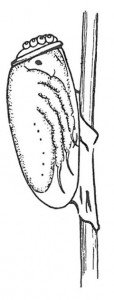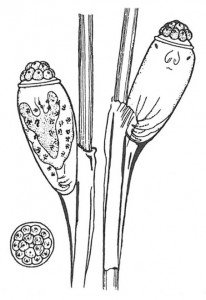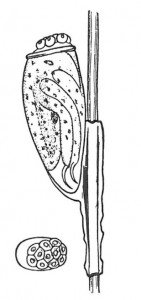Head lice glue their eggs (called nits) to the base of the hairs. The glue hardens within 20 seconds, and then is insoluble. The glue is made up of a substance which – chemically speaking – is similar to hair. The nits are laid one by one and are quite large compared to the lice. A nit measures 0.3 x 0.8 mm. In the upper part of the nit, there is a crease all the way around. At the top, there are some hemispherical opercula. They act as valves, allowing the nit to breathe.
The hatching time is about a week from when the egg is laid. At the time of hatching, the nit cracks in the crease and the upper part opens as a lid. Next, the nymph swallows air, forming an excess pressure in the nit shell behind it. Eventually the pressure is so high that the nymph is literally shot out of the nit.
The active stages. Newly hatched lice, nymphs, are similar to adults but are smaller. In total, the three nymph stages last 8-10 days. The females begin to lay nits 2-3 days after they have become adults. This gives a total development time from nit to nit of 17 – 20 days. Female lice can live up to 30 days and lay 160-200 nits.
Nighttime activity. Head lice prefer high humidity, temperatures around 30° C and dark surroundings. Preferably, they suck blood at night. The nits are also laid during the nighttime when the head is at rest. A female louse can lay 8 nits every night, and has to mate before each nit lying. There are usually only a few males and the most virile of them have busy nights, having to mate dozens of times and have time to suck blood in between. During the day, lice spend their time eating a little, and in between the small meals, there are long periods of sitting still and digest the blood.
Steady age distribution. At the beginning of a lice infestation, there may be many lice on a head but after a while there will be fewer. It is common that the population steadies, so that in a very long period, there are only 100-200 lice. Of these, 90% are in the nymph stages, 7% are females and 3% are males. With a steady number of lice, where the females each lay 8 per nits each night, the daily mortality and level of emigration must be quite high. Up to 56-112 nits are laid each day to maintain a population of only 100-200 lice.
 |
 |
 |
Fig 6. The only obvious difference between the head and body lice nits, is the amount of glue that attaches the nits to the hair. Head lice nits and body lice nits have some common characteristics: the protuberances do not cover the entire lid, the cross-section of the nits is oval and the nymph is positioned with its stomach in towards the hair. Pubic lice nits are smaller, more rounded in cross section and attached with more glue. The protuberances cover the entire lid and the nymph sits alongside the hair. (After Martini)




